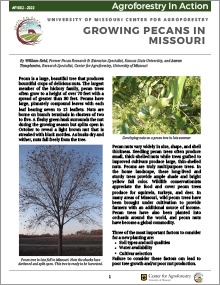Editor's note
This page currently contains only the introductory section of this guide. For the entire text, please download the PDF.

Pecan is a large, beautiful tree that produces bountiful crops of delicious nuts. The largest member of the hickory family, pecan trees often grow to a height of over 70 feet with a spread of greater than 80 feet. Pecans have large, pinnately compound leaves with each leaf bearing seven to 13 leaflets. Nuts are borne on branch terminals in clusters of two to five. A fleshy green husk surrounds the nut during the growing season but splits open in October to reveal a light brown nut that is streaked with black mottles. As husks dry and wither, nuts fall freely from the tree.
Pecan nuts vary widely in size, shape, and shell thickness. Seedling pecan trees often produce small, thick-shelled nuts while trees grafted to improved cultivars produce large, thin-shelled nuts. Pecans are truly multipurpose trees. In the home landscape, these long-lived and sturdy trees provide ample shade and bright yellow fall color. Wildlife conservationists appreciate the food and cover pecan trees produce for squirrels, turkeys, and deer. In many areas of Missouri, wild pecan trees have been brought under cultivation to provide farmers with an additional source of income. Pecan trees have also been planted into orchards around the world, and pecan nuts have become a global commodity.
Three of the most important factors to consider for a new planting are:
- Soil types and soil qualities
- Water availability
- Cultivar selection
Failure to consider these factors can lead to poor tree growth and/or poor nut production.
Topics
- Soil and water requirements
- Cultivar selection
- Methods for establishment
- Care and equipment
- Resource list
Pages
- 16